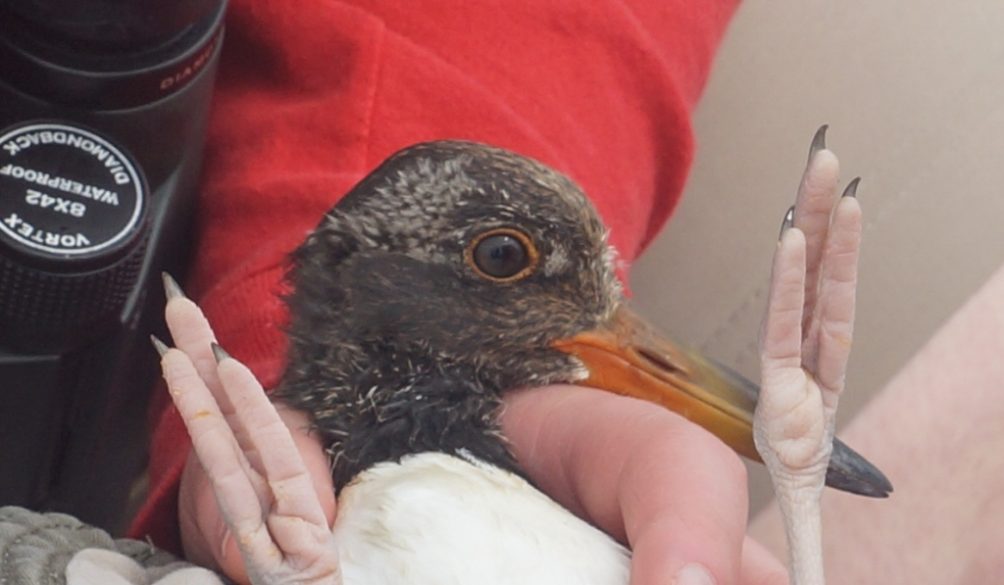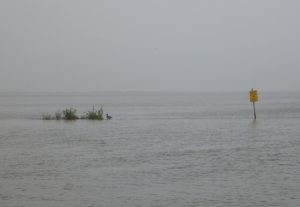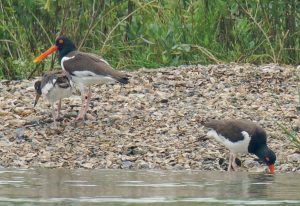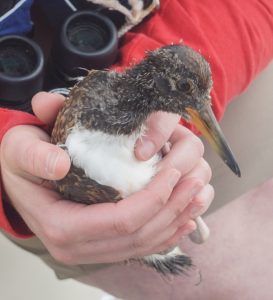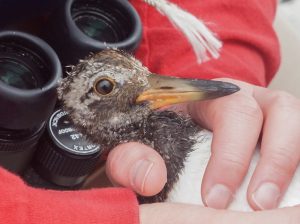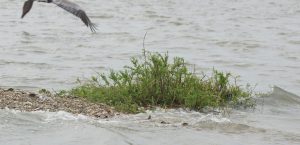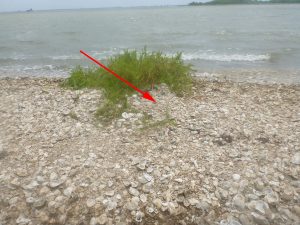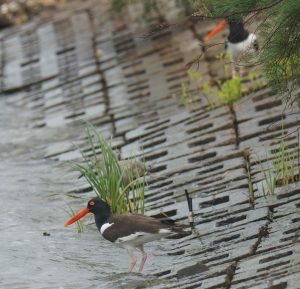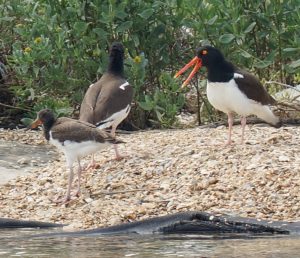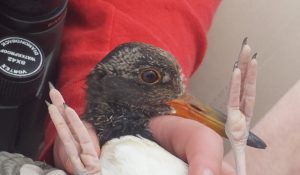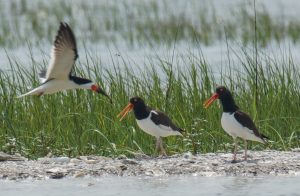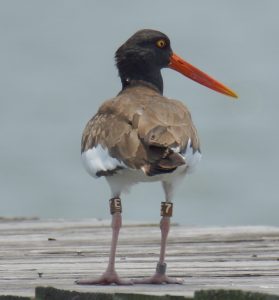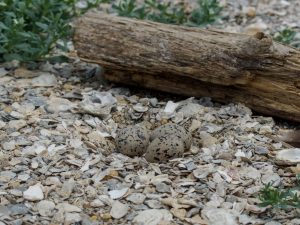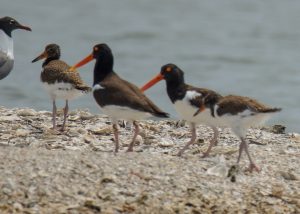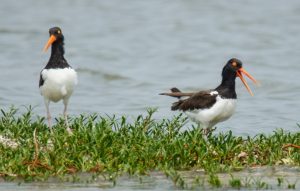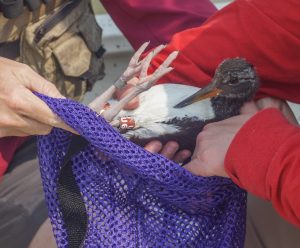By Susan Heath
Well the weather really messed me up this week. We were supposed to do our American Oystercatcher Experiences Auction trip on Wednesday and on Friday I was supposed to go and count Black Skimmer colonies in West Galveston Bay. On Wednesday the wind was blowing 18 – 20 mph so I had to reschedule the auction trip for next Monday. On Friday the forecast was for lots of rain so clearly a trip counting skimmers was out. There were several oystercatcher chicks that needed to be banded this week because they are due to fledge soon and I didn’t want to risk waiting until next week. I’ve had the experience of trying to catch a chick to band it only to have it fly away one too many times! My solution was to combine both trips and go on Thursday which amazingly had very nice weather sandwiched in between the bad stuff on Wednesday and Friday. Alan Wilde and Amanda Hackney (Blackcat GIS) joined me for this little adventure.
We left the Tiki Island boat ramp at 8:00. I was happy to see that the boat ramp pair (F0A & unb) were there on the dock. Last week I thought they might have abandoned the area since we didn’t see them. Staying might not be the best choice though. The tide was so high today one of their islands looked like this:
We checked on the birds in Jones Bay on our way to band the chicks but nothing was happening there. Our first target chick belonged to an unbanded pair just off the GIWW. Fortunately the whole family was standing on a small shell bank by themselves and the chick only ran a few feet before laying down making it easy to grab it without disturbing any other birds.
We’ve tried to catch the adults a couple of times and they are too smart for us but they apparently didn’t pass their smarts on to their chick! It was smaller than I expected and probably won’t fledge next week but I don’t like to catch them twice as they get smarter each time so we went ahead and banded it. Welcome to the family U5W.
Next we tackled YM & JH’s chick. It also didn’t run very far before jumping into the water and I easily snagged it with the dip net. This one was smaller than expected as well and it had a sore on its foot likely from hiding in the cactus where Alan snapped a photo of it last week. The foot was a little swollen but not too much and it wasn’t limping so hopefully it will be ok. Meet U5X.
Then we went to get C1A & unbanded’s chicks. Last week there were two of them and these were the ones closest to fledging so I really needed to get them. When we got there we only saw one adult and one chick. We watched a few minutes but the other adult and chick didn’t appear so we went ahead and went for the one. It ran and hid somewhere and we couldn’t find it. Drat! Amanda found a curled up rattlesnake though and that was enough to make me decide to give up and try again later.
We checked on J6 & UF while we were there. I was pretty sure their lovely three egg nest had overwashed and sure enough here’s what it looked like today and a photo showing where the nest was.
Bummer. I was hoping they had a chance. We found that H0 & JC were guarding a one egg nest on Marker 52. 28 & AP appeared to be doing the same but their location is full of nesting terns so I didn’t go up and check.
We headed southwest down the GIWW and found that both ET & A8A and XE & unbanded’s nests had overwashed. I wasn’t surprised because the tide had gotten up to three feet on Wednesday with the strong south wind holding all the river inflow in the bays. Usually we turn around there and head back up into the east end of the bay but I needed to check an area at the west end of the bay along the GIWW called Alligator Point for skimmers so we kept going.
Eagle eye Amanda spotted a pair of oystercatchers feeding on the rip rap along the GIWW near Cow Bayou. Neither of them was banded so we’ll keep an eye on them for a future trapping attempt.
A little further on we came to the West Bay mooring facility which has a few huge mooring buoys for barges. There’s a long skinny island there and lo and behold we found this.
What’s that you say? It’s a pair of oystercatchers with a big chick! These weren’t banded either but their chick is now! Meet U6Y.
It will probably fledge in the next week so we caught it just in time. There is a pair of oystercatchers at Alligator Point and another pair at Alligator Point island. We only saw individual for each pair so I’m sure the other two were on nests somewhere that we couldn’t see. There weren’t any Black Skimmers there but the terns were packed in so tightly it was amazing.
I’m glad I don’t have to count them for the colonial waterbird count! That would be hard. We headed across the bay to the Galveston Island shoreline and checked out Bay Harbor where there is an island that in the past has had a lot of Black Skimmers. We found no skimmers and another set of well packed terns.
Cynthia Hughes lives in that area and had reported a pair of oystercatchers there on a nest a few weeks ago but we couldn’t find them. Perhaps the terns pushed them out or with the tide so high they had no place on the island to hang out.
We headed east along the Galveston Island shoreline to McAllistar Point where we finally some skimmers and two pairs of unbanded oystercatchers.
I videoed the skimmers for counting later. Neither oystercatcher pair had a nest or a chick so we moved on to Jumbilee Cove. There were some skimmers there too but no oystercatchers.
Next was Carancahua Cove which is where Galveston Island State Park is. Alan and I went in there for oystercatchers last year when the tide was low and we had a heck of a time getting around. This time with the tide so high and we had no problem but we also only saw two oystercatchers and both were just feeding. There were skimmers there trying to make a go of it though so I videoed them and we moved on.
The last two spots for skimmers were Hoecker’s Point and Starvation Point. Both appeared to be underwater but I found myself wondering how Starvation Point got its name. I’m sure that’s a sad story. I couldn’t find any information online. Anyway, that was the end of the skimmer discovery tour and we headed up to Gangs Bayou to check on the rest of the oystercatchers.
Happily JX & unbanded still had two eggs and JX was incubating them. Go JX! The tide was so high that A4A & unbanded had no beach to hang out on so we didn’t see the chicks but one of them was up in the vegetation so I’m sure they were fine. A1A & unbanded were hanging out on the breakwater as the sandy mound where they try to nest was under water. We found only one oystercatcher on the docks. E7 was hanging out there alone and appeared to be limping. Alan’s photos didn’t reveal an injury so hopefully it’s something minor.
On South Deer both KK & unbanded and LL & unbanded’s nests had overwashed. Not surprising since their beaches are both south facing and the wind had been blowing so strong from the south on Wednesday. Try again guys. Sorry!
It was time for Y7 & unbanded and XA & unbanded’s nests to be hatched so I was anxious to check on them. Y7 & unbanded were standing along the shoreline and I saw a small chick run behind a shell ridge so we know they have at least one chick. There are gulls everywhere there but they managed to fledge a chick last year so hopefully they’ll be able to this year as well.
XA & unbanded were not anywhere near where their nest had been though and we didn’t see a chick with them either. Maybe they’ll fool us though. It’s happened before!
Next we checked on JN & UW. I’ve been trying to determine whether they have a chick or not for a couple of weeks. This week it was pretty clear they must have failed. They were laying down on a small shell bank with some gulls that was surrounded by water. They stood up when we approached and eventually flew off. There was no chick there anywhere sadly. HL & unbanded’s nest had also overwashed so of the six pairs on South Deer only one has a chick so far. Bummer.
Now it was time to check on 16 & unbanded, the pair that nests on Galveston Island near 8 Mile Road. I figured their nest would have overwashed and unfortunately I was right. We found them in a completely different area standing up on a shell ridge. They’ve tried to nest where they were standing before but they always fail. I assume a predator gets them there and the spot where they had their nest (their third try) always gets overwashed. I wish I could do something to help them!
We headed over to Jigsaw and found XU standing at one end. Hum. XU I don’t think the nesting pairs are going to be very happy about your presence. We went to check on LH & WW’s nest and found it overwashed, but they were standing nearby. Our approach spooked them and when they flew off they noticed poor XU and the battle began. Sorry buddy but it was bound to happen sooner or later.
The other two pairs, YE & unbanded and T5 & T6 were still incubating their nests (two eggs and three eggs respectively) so that was good. I’m still so psyched that T5 & T6 laid their nest in the middle of the debris pile we created with natural material to give their chicks a place to hide.
Next was Struve Luci where we found L9 & unbanded with their two chicks in tow amongst the skimmers.
LT & JA’s area was under water and we didn’t see their chick U5U either. 12 & unbanded’s nest had overwashed and they weren’t happy about it (their third try as well).
Because the tide was so high, the birds were displaced and we kept seeing groups of three, four, five or even six oystercatchers together which made it hard to figure out what was going on. HM & X7 were on a dock smartly staying out of the fray. I was sad not to see little U5U but perhaps it was off on its first journey without mom and dad. You know those teenagers. Hopefully we’ll see it next week. We videoed the skimmers (there are over 400 there now!) and went back to try to get C1A’s chick again.
This time both adults were up on a shell ridge together with the chick and I saw right where it ran to hide. Fortunately it was a clear shell path to get to it so I didn’t have to worry about a hidden rattlesnake. This chick was full sized and will be fledge any day so we got to it just in time! Here’s U6U.
After a full day of mostly successes we headed back to the boat ramp ready to be done! I was pretty tired but it was a good day and we got done what we needed to get done. There are more chicks to band next week and hopefully some of the overwashed pairs will try nesting again. It’s not over yet!
This project is supported solely by donations and small grants. If you’d just like to make a donation (thank you!) you can do so on our website here.
Current Stats for upper Texas coast from Dickinson Bay to East Matagorda Bay: 6 nests being incubated, 53 failed nests, 7 nests with unfledged chicks, 0 nest with undetermined status, 1 chick fledged
Note: All trapping and banding for this project is in accordance with federal and state permits issued to Susan Heath, GCBO Director of Conservation Research. Bird handling by volunteers is only permitted in the presence of Susan Heath and volunteers are trained in proper bird handling techniques.

